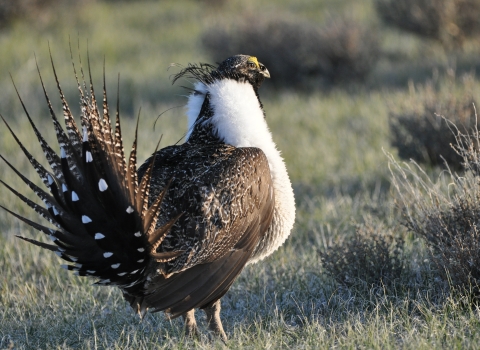Since at least 1950, biologists with the U.S. Fish and Wildlife Service have been conducting an aerial survey of whooping cranes on their wintering grounds in coastal Texas on and around Aransas National Wildlife Refuge. This longstanding survey has provided insight into the long-term population trends of this species. Once near the brink of extinction, the whooping crane population is now estimated to be over 500 individuals. This year the survey has been canceled, as have many other similar surveys, due to human health concerns associated with the COVID-19 pandemic.
“Aerial surveys involve a pilot and at least two observers in a small plane for up to four hours at a time,” said Wade Harrell, U.S. Fish and Wildlife Service Whooping Crane Recovery Coordinator. “Due to the close exposure this survey requires and the fact that our pilots and observers often travel in for this effort from different parts of the country, we decided to forgo the aerial survey this winter with COVID-19 cases currently spiking. Fortunately, missing one survey year out of many will not significantly affect our ability to monitor long-term population trends while maintaining the health and safety of our staff. Further, other activities conducted by our partners can help fill information gaps that may occur.”
Citizen scientists have long contributed to the tracking of whooping cranes through the Texas Parks and Wildlife Department’s Texas Whooper Watch program by reporting whooping cranes, particularly those outside of the aerial survey area. Additionally, the Service is working with partners at the International Crane Foundation to pilot a new online application this winter with a small group of citizen scientists to report banded whooping cranes. This information can help the Service better understand whooping crane survival patterns through the winter.
“While we are disappointed that the historic aerial survey will not take place this year, we are encouraged by the fact that enduring partnerships enable us to continue to monitor the population this winter in a safe way,” Harrell said.
Biologists plan to resume the aerial survey in January 2022 and are continuing to mark whooping cranes with telemetry tracking devices this winter as part of an ongoing joint research project between the United States and Canada.
Whooping cranes are one of the rarest birds in North America and are highly endangered. Cranes have been documented to live more than 30 years in the wild. Adults generally reach reproductive age at four or five years, and then lay two eggs, usually rearing only one chick.
More information about the survey and whooping cranes can be found on the Aransas National Wildlife Refuge website at http://www.fws.gov/refuge/Aransas/ or by calling the Aransas National Wildlife Refuge Visitor Contact Station at: (361) 349-1181.
The mission of the U.S. Fish and Wildlife Service is working with others to conserve, protect, and enhance fish, wildlife, plants, and their habitats for the continuing benefit of the American people. We are both a leader and trusted partner in fish and wildlife conservation, known for our scientific excellence, stewardship of lands and natural resources, dedicated professionals, and commitment to public service.
For more information on our work and the people who make it happen, visit www.fws.gov. Connect with our Facebook page at www.facebook.com/usfws, follow our tweets at www.twitter.com/usfwshq, watch our YouTube Channel at http://www.youtube.com/usfws and download photos from our Flickr page at http://www.flickr.com/photos/usfwshq.


